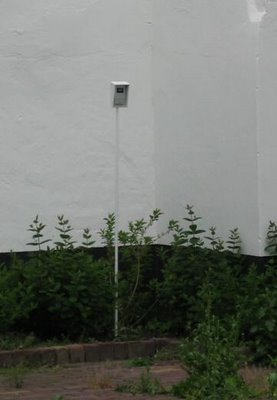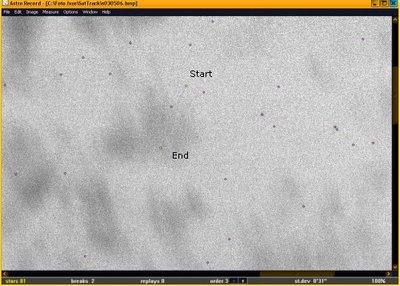A clear evening again after many days with rain and hailstones. Slight haze but otherwise good, +10 C. I managed to capture IGS 1B (03-009B) and Lacrosse 5 (05-016A).
Lacrosse 5 (05-016A) briefly and unexpectedly flared to mag -2.0 at 22:02:20 UTC (+/- 10s) while I was preparing the camera. It made a distinctly yellow impression in colour. Food for Philip!
03-009B was 2.8s early relative to elset 06135.93706251, while 05-016A was 0.4s late relative to elset 06141.91063216
At this moment, the sky is overcast again.
THE SECRET SPIES IN THE SKY - Imagery, Data Analysis, and Discussions relating to Military Space
SatTrackCam Leiden (Cospar 4353) is a satellite tracking station located at Leiden, the Netherlands. The tracking focus is on classified objects - i.e. "spy satellites". With a camera, accurate positional measurements on satellites of interest are obtained in order to determine their orbits. Orbital behaviour is analysed.
This blog analyses Missile tests too.
Friday, 26 May 2006
Wednesday, 24 May 2006
The weather, weather data for Cospar 4353, and the Navy Googling for USA 129
Weather is still bad here. Yesterday afternoon it looked like I could do some observations, as it nearly completely cleared, but in the evening fields of cumulus came in again. At this moment, it is raining and we even had hailstones today. The bad weather the past week means I could not test Phil Masding's predictions for several Lacrosse 5 flares by observing them.
On another note: last weekend saw my weather station becoming operational. I purchased a small electronic (radiographic) weather station through ebay recently. After some sawing, hammering and painting activities resulting in a 1.5 meter pole with an half-open small casing on it, the sensor is now on the courtyard and sending its temperature records to the receiver in my home. A daily report of measured maximum- and minimum temperatures and air pressure at Cospar 4353 can now be found here.

I had the US Navy visiting my webpage today. Someone there Googled for "USA 129". I have more military visits every now and then.
24/05/2006 17:30 CEST temp. 10.1 C, air presssure 1016 hPa
On another note: last weekend saw my weather station becoming operational. I purchased a small electronic (radiographic) weather station through ebay recently. After some sawing, hammering and painting activities resulting in a 1.5 meter pole with an half-open small casing on it, the sensor is now on the courtyard and sending its temperature records to the receiver in my home. A daily report of measured maximum- and minimum temperatures and air pressure at Cospar 4353 can now be found here.

I had the US Navy visiting my webpage today. Someone there Googled for "USA 129". I have more military visits every now and then.
24/05/2006 17:30 CEST temp. 10.1 C, air presssure 1016 hPa
Sunday, 21 May 2006
Meeting other satellite observers
Yesterday I travelled to Belgium to meet some other satellite observers out of the BWGS at the home of Bram Dorreman. The meeting was as well a BWGS meeting, a birthday meeting for Bram Dorreman, and a meeting to celebrate his 40th anniversary as a satellite observer.
Leo picked me up by car at Vleuten and we then continued to fetch Wim and a Belgian lady Marieke. Other joining at Bram's house were Tristan and Kurt. The meeting was very pleasant and informal, we were cared for very well in terms of drinks and food by Bram and his wife. For me, this was the first time I met other satellite observers except of Bram.
Wim brought some bulletins out of the "old box" with him. Kurt demonstrated the latest development of his internet PPAS database. Bram brought us back to the early days, by demonstrating the 'ancient' and time consuming graphic technique for predicting satellite passes of yesteryear. Ah, so much has changed...
It was a fun meeting.
The weather is very bad here the past week. Heavy rain showers and thick cloud cover.
Leo picked me up by car at Vleuten and we then continued to fetch Wim and a Belgian lady Marieke. Other joining at Bram's house were Tristan and Kurt. The meeting was very pleasant and informal, we were cared for very well in terms of drinks and food by Bram and his wife. For me, this was the first time I met other satellite observers except of Bram.
Wim brought some bulletins out of the "old box" with him. Kurt demonstrated the latest development of his internet PPAS database. Bram brought us back to the early days, by demonstrating the 'ancient' and time consuming graphic technique for predicting satellite passes of yesteryear. Ah, so much has changed...
It was a fun meeting.
The weather is very bad here the past week. Heavy rain showers and thick cloud cover.
Wednesday, 10 May 2006
Yesterdays Lacrosse 3 data
Russell Eberst reported data for Lacrosse 3 (97-064A) from last night as well, from a later pass. Our results quite agree:
STA___XTRK___deltaT___Perr
4353___0.04___-0.83___0.450
4353___0.02___-0.74___0.416
2420___0.02___-0.86___0.448
(STA = station, with 2420 being Russell; XTRK = cross-track error in degrees; deltaT = timing error in seconds, with negative meaning 'early'; Perr = positional error in degrees)
Relative to elset 06125.89779354, the satellite was some 0.8 seconds early.
STA___XTRK___deltaT___Perr
4353___0.04___-0.83___0.450
4353___0.02___-0.74___0.416
2420___0.02___-0.86___0.448
(STA = station, with 2420 being Russell; XTRK = cross-track error in degrees; deltaT = timing error in seconds, with negative meaning 'early'; Perr = positional error in degrees)
Relative to elset 06125.89779354, the satellite was some 0.8 seconds early.
Lacrosses and IGS 1B, and veil clouds
Summer has arrived: it is very sunny the past week, and I finally can leave my jacket at home and walk about in shorts and shirt, even observe in a T-shirt.
Nevertheless, sky conditions are not optimal. There is a thin veil in the skies, which in an urban environment like Leiden (and with moonlight now entering as well) is deadly to photographic observations. This was shown again last night: sat passes that were visible with the naked eye, drowned in the background fog on the photographic image. So I have seen Lacrosse 2, Lacrosse 3 and IGS 1B, but can only present positions for Lacrosse 3 as the other images did not yield measurable trails. The result on Lacrosse 3 was obtained in strong twilight before the thin veil clouds arrived. The image too is fogged, by twilight, but did yield a measurable trail and enough stars so I measured it and reported it.
Nevertheless, sky conditions are not optimal. There is a thin veil in the skies, which in an urban environment like Leiden (and with moonlight now entering as well) is deadly to photographic observations. This was shown again last night: sat passes that were visible with the naked eye, drowned in the background fog on the photographic image. So I have seen Lacrosse 2, Lacrosse 3 and IGS 1B, but can only present positions for Lacrosse 3 as the other images did not yield measurable trails. The result on Lacrosse 3 was obtained in strong twilight before the thin veil clouds arrived. The image too is fogged, by twilight, but did yield a measurable trail and enough stars so I measured it and reported it.
Thursday, 4 May 2006
USA 129 under very bad conditions
Just when I was about to start my observing activities in late dusk yesterday evening, a thin motled cloud cover came in.
Much to my surprise, I did manage to get some results on USA 129 (96-072A) . The trail is visible through the cloud cover. Below a (reduced quality) shot of the Astrorecord screen: negative for clarity, and some image contrast enhancement has been performed before loading the image into Astrorecord.

As can be seen, not quite an ideal catch! Normally I would not have reported data from such a marginal cloud-interfered trail. Yet in this case I did do because I hoped they migth be of help to analysts and Bjorn Gimle after his post here.
Much to my surprise, I did manage to get some results on USA 129 (96-072A) . The trail is visible through the cloud cover. Below a (reduced quality) shot of the Astrorecord screen: negative for clarity, and some image contrast enhancement has been performed before loading the image into Astrorecord.

(click image for larger picure)
As can be seen, not quite an ideal catch! Normally I would not have reported data from such a marginal cloud-interfered trail. Yet in this case I did do because I hoped they migth be of help to analysts and Bjorn Gimle after his post here.
Wednesday, 3 May 2006
IGS 1B, bad luck with the KH's
Managed to get 2 images (4 positions) on IGS 1B yesterday evening. It was 3s early and clearly off in cross-track relative to elset 06115.87140454.
Had bad luck with the Keyholes. I missed a pass of USA 129 as the sky was obscured by an untimely pach of clouds. I did see USA 186 with the naked eye, but lost the image, because an error occurred while the camera was writing the data to the memory card.
Had bad luck with the Keyholes. I missed a pass of USA 129 as the sky was obscured by an untimely pach of clouds. I did see USA 186 with the naked eye, but lost the image, because an error occurred while the camera was writing the data to the memory card.
Subscribe to:
Posts (Atom)